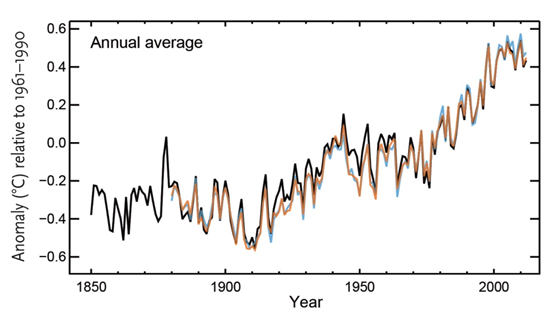Ros Donald
27.02.2014 | 6:21pmToday two major national academies have laid out what scientists know about climate change.
The report, by the UK’s Royal Society and the US National Academy of Sciences, answers 20 commonly-asked questions about climate change, as well as an overview of the basics. Its aim: to make clear to policymakers and the public “what is well established, where consensus is growing, and where there is still uncertainty”.
In addition to providing a clear guide for non-scientists, the report could be seen as a response to media coverage that overplays scientific uncertainty to cast doubt over climate science as a whole.
The big picture
The report presents what scientists know about climate change as the culmination of many lines of evidence, all pointing in the same direction.
We can measure that the world’s temperature is increasing: earth’s average surface temperature has increased by about 0.8 degrees Celsius since 1900, with much of this increase happening after the mid-70s.
The graph below shows the rise in s global average surface temperature between 1850 and 2012, showing combined land and ocean measurements. The different colours represent different global datasets.

Taken from report. Source: Intergovernmental Panel on Climate Change
0.8 degrees may not seem like much. But the report explains that warming of just a few degrees means big changes. The end of the last ice age saw fundamental alterations in the earth’s climate after warming of just four or five degrees Celsius.
And the speed of current climate change is far faster than most of the past events. As the report puts it: “This speed of warming is more than ten times that at the end of an ice age, the fastest known natural sustained change on a global scale” – leaving human society and the natural world little time to adapt to new conditions.
Surface temperature data isn’t the only line of evidence available to scientists: as the report summarises, they can also observe that Arctic sea ice extent is going down, while oceans are getting warmer. Snowfall is diminishing, while oceans are rising. Plants and animals that usually keep to warmer oceans are travelling towards the poles, taking advantage of warmer temperatures, the report says.

Taken from report. Source: NOAA
Fingerprinting
But why are scientists so sure this is all humans’ fault? The report explains extra carbon dioxide emitted by industrial activity since the late 1800s – coupled with activities like deforestation – has upset the earth’s natural carbon balance.
Scientists expect the extra carbon dioxide released from fossil fuels to stick around in the atmosphere for thousands of years. And the more we emit, the higher surface temperatures will be. The report also points out that even if emissions stopped, temperature would continue to rise for a while.
The ‘pause’ and other uncertainties
The science is “much more definite than you think”. That’s what Professor Eric Wolff at the University of Cambridge said at this afternoon’s presentation. But media discussions about climate change have amplified areas where scientists are less certain.
An apparent slowdown in the amount of warming recorded at the earth’s surface over the past 15 years was a hot topic last year, prompting soul-searching within the scientific community about how well it was communicated.
The report aims to put this variation in context, pointing out that warm and cold decades have been seen over the past 150 years of observations, usually due to natural factors like heat-reflecting particles from volcanic eruptions. But the long-term trend bears the predictions of continuous greenhouse gas warming out.
Professor Ben Santer at the Lawrence Livermore National Laboratory told the meeting: “The warming hiatus is a fascinating detective story.” But the slowdown in the warming of the lower atmosphere does not invalidate scientists’ understanding of the human effect on climate, he added.

Taken from report. Source: Met Office, based on the HadCRUT4 dataset from the Met Office and Climatic Research Unit
The climate’s effect on extreme weather events has also been a live topic after people all over the globe suffered extremely odd weather – from above-average temperatures in cold places, to the US’s polar vortex and the UK’s extreme rainfall. As human emissions have made the earth’s lower atmosphere warmer and wetter, there’s more energy available for storms and some extreme weather events.
The report says:
“Consistent with theoretical expectations, heavy rainfall and snowfall events (which increase the risk of flooding) and heatwaves are generally becoming more frequent.”
Recent extreme weather has got people thinking about climate change. This afternoon’s panel suggested that as long as scientists make statements that stick closely to the available evidence such events can be an opportunity for discussions with the public and policymakers about how climate change might affect events such as these.
An exciting intervention?
This is a significant report from two of the world’s most authoritative scientific bodies. But the significance may be more in how the report is presented, than the fairly familiar scientific picture that it presents.
From the writing style to the layout, and the decision to structure it as a question and answer sequence, the report has been designed to be as accessible as possible to non-expert readers. The authors provide an example of how scientists can stress areas of certainty in the science. Their discussion of uncertainties is not allowed to eclipse the overall scientific picture.
The Royal Society and National Academy of Sciences appear to have fleshed out a new model for how scientists can talk about climate science. At a time when some are keen to stress the uncertainties and limitations of climate science, that may be a smart move.

